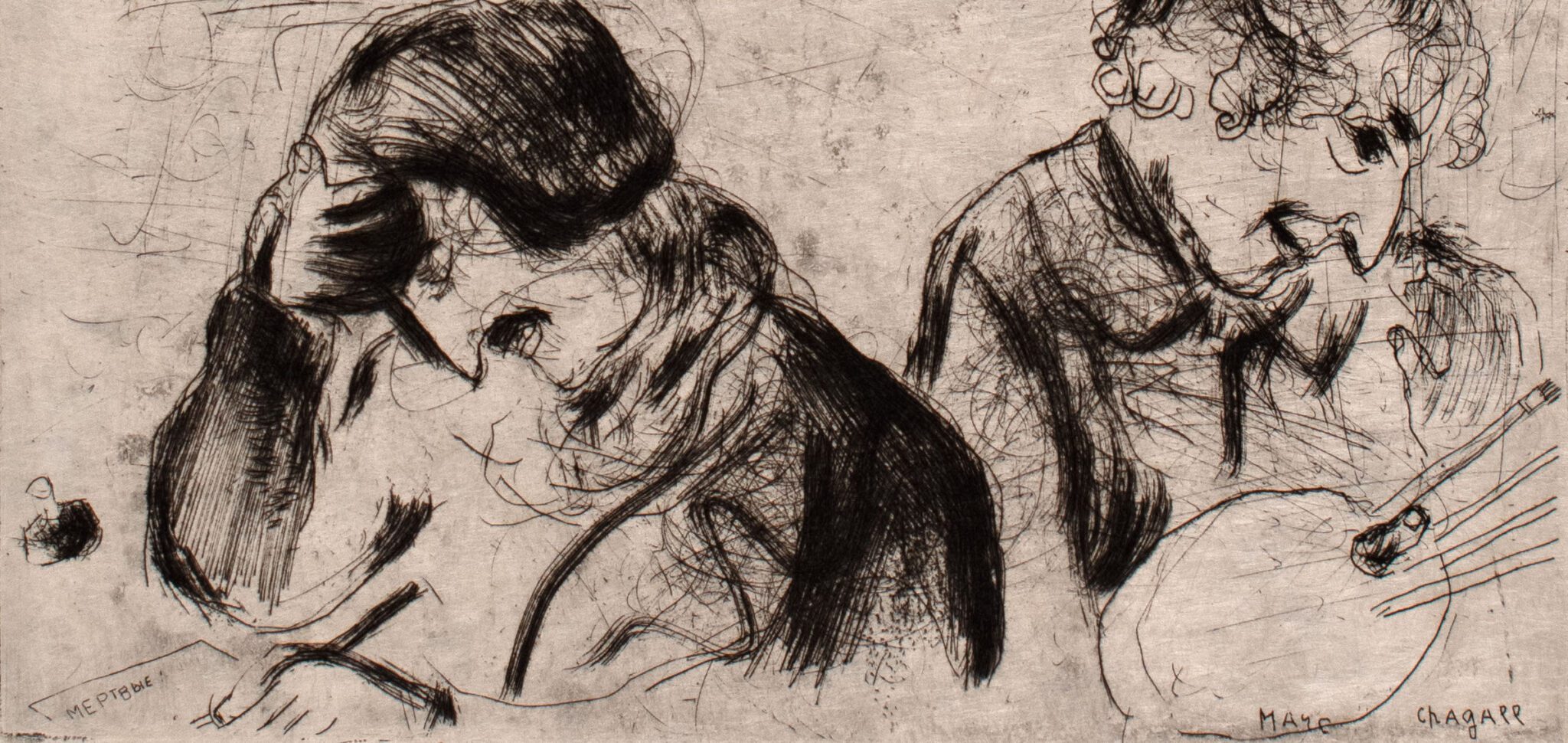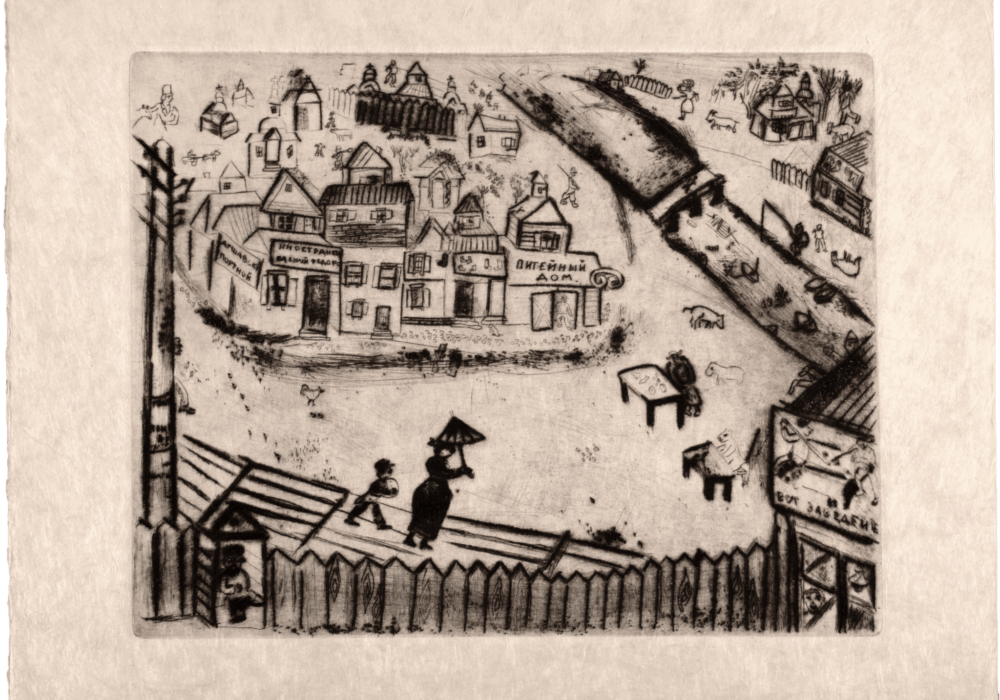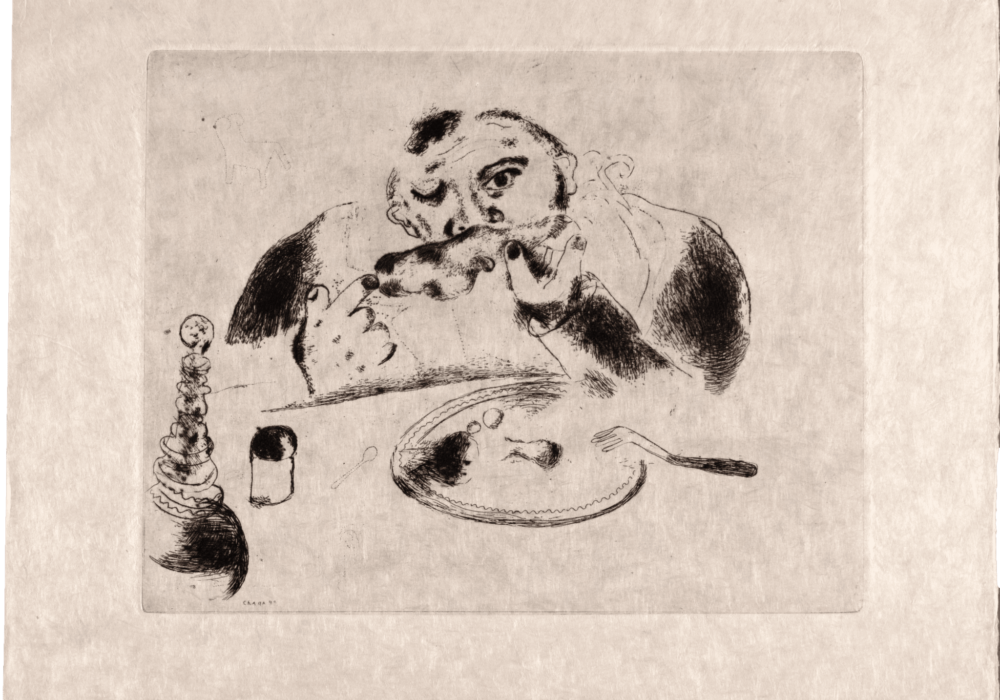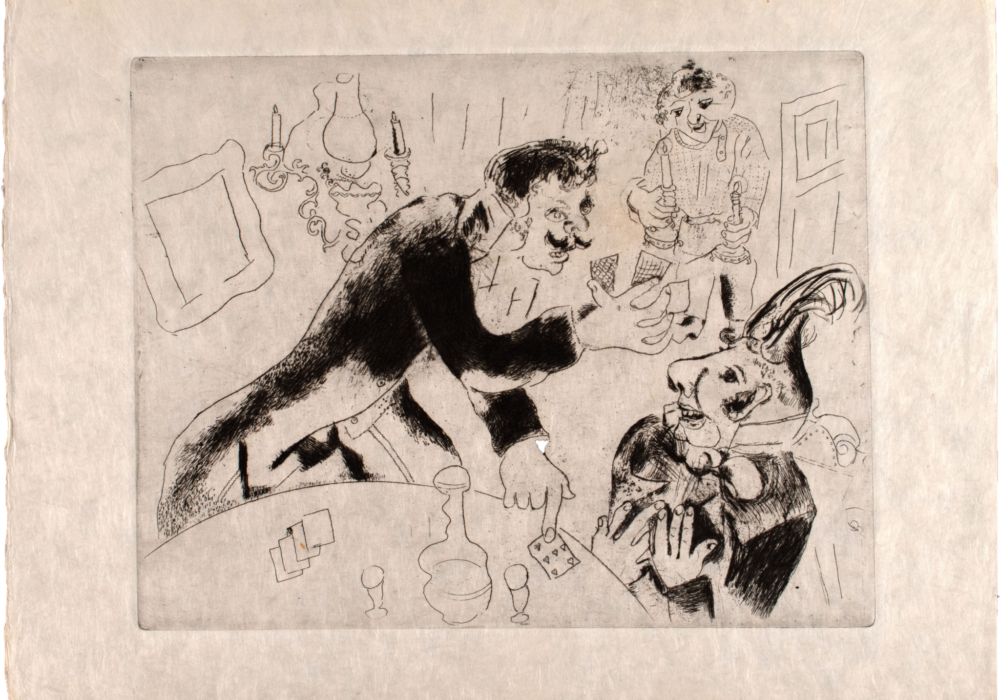June 7 - September 8, 2024
Artist Marc Chagall’s 96 imaginatively exaggerated illustrations bring the tragic and humorous characters populating the provincial country town in writer Nikolai Gogol’s renowned satire, “Dead Souls,” to vivid life. Commenting on the political and social divides in 19th-century Imperialist Russia, the inspired pairing produced a thinly cloaked critique with contemporary parallels.
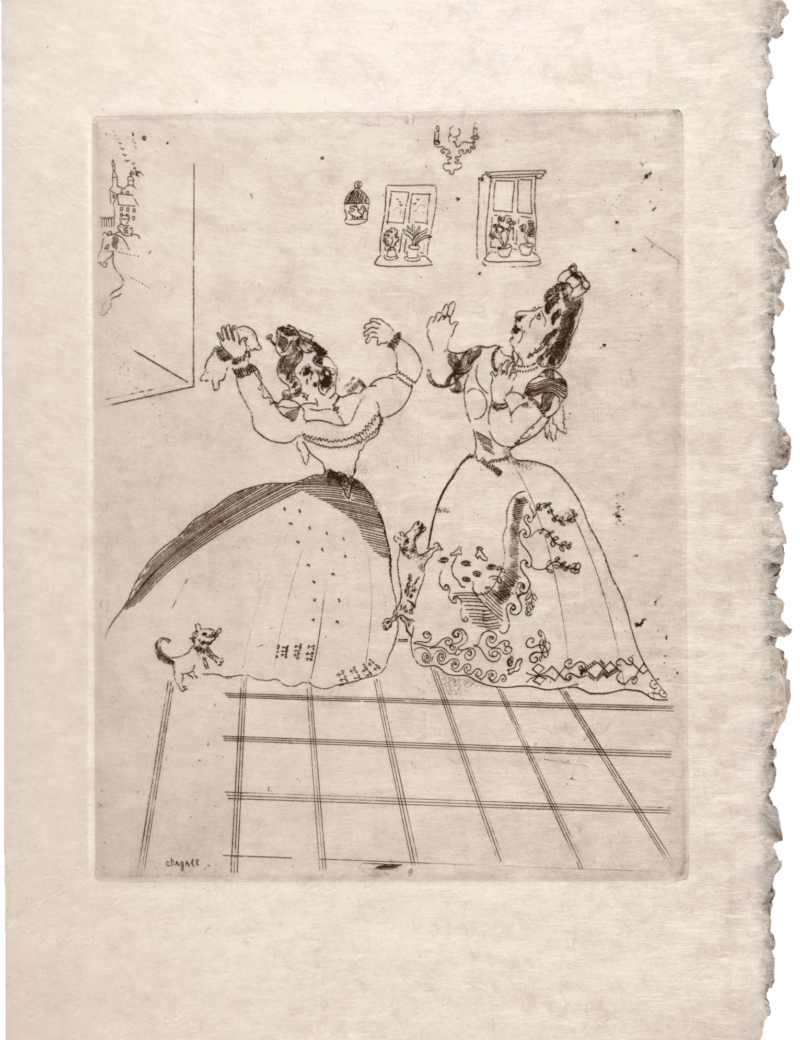
Nikolai Gogol was a Ukrainian-born humorist, dramatist, and novelist whose works, written in Russian, significantly influenced the direction of Russian literature.
Marc Chagall has been described as the greatest Jewish painter of all time. His artwork shifts constantly from reality to fantasy, from physical to spiritual, just as his life brought him face-to-face with different worlds of Russia and France, and conflicting sources of inspiration.
“Dead Souls,” Russia’s first major novel, is one of the most unusual works of nineteenth-century fiction and a devastating satire on social hypocrisy.
When the satirical words of Gogol, and the surrealist, folkloric imagery of Chagall met on paper, the magical pairing was undeniable. The tragedy and humor of existence in 19th-century Imperialist Russia are embodied by the despicable, colorful protagonist of Gogol’s tale, aptly rendered and brought to life by Chagall’s caricature-like etchings.
Throughout “Dead Souls,” Gogol and Chagall are equally uninterested in strict realism, but their portraits of nobles who speak French more than Russian, daydream rather than become adequate estate managers, and are so blinded by rank and status they cannot detect a con artist, make the combined works an instant classic.
Rarely seen together, all 96 black-and-white etchings are on view, in collaboration with the University of Wisconsin-Milwaukee Art Collection and Emile H. Mathis Art Gallery.
Opening Preview
Thursday, June 6, 7:00 – 9:00 p.m.
Join us to celebrate the satirical world created by Gogol and Chagall with a tour from Chief Curator, Molly Dubin. Get a sneak preview of Christine Wenc’s anticipated book “Funny Because It’s True: How The Onion Created Modern American News Satire.” And enjoy light appetizers, dessert and wine.
Where Gogol Got Souls: Slavery and Society in 19th-Century Russia
Tuesday, June 18, 7:00 – 8:15 p.m.
Join Joe Peschio, Associate Professor of Russian at UW-Milwaukee, to learn the basics needed to understand Gogol’s masterpiece, Dead Souls, and its resonance in Russian culture.
Forged Identities, or, Where’s the Art and What’s the Deal in Nikolai Gogol’s Dead Souls?
Wednesday, July 31, 7:00 – 8:15 p.m.
Are Gogol’s characters in Dead Souls realistic portraits or false creations arising from his spiritual torments? Do this Ukrainian-born writer’s works have anything to tell us about Russia’s war against Ukraine or Russian literature’s possible complicity in current horrors? Join Andrew Reynolds, Associate Professor of Slavic Languages at UW-Madison, for an examination of the various enigmas and paradoxes of Gogol’s life and art.
Where Does Russia End? Russian Imperialism & Anti-Ukrainianism from Past to Present
Thursday, August 8, 7:00 – 8:15 p.m.
Join Christine Evans, Associate Professor of History at the UW-Milwaukee, to explore both the long history of the Russian state’s efforts to conquer its Western neighbors and decide who and where is Russian, and the imperialist narratives that have accompanied and sought to justify that effort.
The Colors of Chagall: A Family Art Day
Sunday, August 25, 1:00 – 3:00 p.m.
Join us in celebration of Chagall’s love of color with a family-friendly day featuring all-ages art activities!
- Make-and-take printmaking demonstrations
- Show your colors and chalk our walk
- A scavenger hunt to help your family navigate the Museum
- Relax within the lines with Chagall coloring books
Nikolai Gogol (born 1809, Sorochintsy, near Poltava, Ukraine, Russian Empire [now in Ukraine]—died 1852, Moscow, Russia) was a Ukrainian-born humorist, dramatist, and novelist whose works, written in Russian, significantly influenced the direction of Russian literature. His novel Myortvye dushi (1842; Dead Souls) and his short story “Shinel” (1842; “The Overcoat”) are considered the foundations of the great 19th-century tradition of Russian realism.
Dead Souls is an absurdist social satire of imperial Russia before the emancipation of the serfs, especially the foibles and customs of the Russian nobility. Though Gogol is not interested in strict realism, his portraits of nobles who speak French more than Russian, daydream rather than become adequate estate managers, and are so blinded by rank and status they cannot detect a con artist, made the work an instant classic. It cemented Gogol’s reputation as a deft and humorous social commentator.
The work—intended to be a trilogy—remains incomplete, ending mid-sentence, as Gogol burned the original conclusion to the second part before his death in 1852.
Plot Synopsis
Chichikov, a mysterious stranger, arrives in a provincial town and visits a succession of landowners to make each a strange offer. He proposes to buy the names of dead serfs still registered on the census, saving their owners from paying taxes on them, and to use these ‘souls’ as collateral to re-invent himself as a gentleman. In this ebullient masterpiece, Gogol created a grotesque gallery of human types, from the bear-like Sobakevich to the insubstantial fool Manilov, and, above all, the devilish con man Chichikov.
Marc Chagall was born in 1887, in Vitebsk, Russia. From 1907 to 1910 he studied in Saint Petersburg, at the Imperial Society for the Protection of the Arts, and later with Léon Bakst. In 1910 he moved to Paris, where he associated with Guillaume Apollinaire and Robert Delaunay and encountered Fauvism and Cubism. He participated in the Salon des Indépendants and the Salon d’Automne in 1912. His first solo show was held in 1914 at Der Sturm gallery in Berlin.
Chagall visited Russia in 1914 and was prevented from returning to Paris by the outbreak of war. He settled in Vitebsk, where he was appointed Commissar for Art in 1918. He founded the Vitebsk Popular Art School and directed it until disagreements with the Suprematists resulted in his resignation in 1920. He moved to Moscow and executed his first stage designs for the State Jewish Chamber Theater there. After a sojourn in Berlin, Chagall returned to Paris in 1923 and met Ambroise Vollard. Soon, Chagall was creating the 96 etchings that illustrate the classic Russian novel, Dead Souls.
During the 1960s Chagall continued to travel widely, often in association with large-scale commissions he received. Among these were windows for the synagogue of the Hadassah University Medical Center, Jerusalem (installed in 1962); a ceiling for the Paris Opéra (installed in 1964); a window for the United Nations building, New York (installed in 1964); murals for the Metropolitan Opera House, New York (installed in 1967); and windows for the cathedral in Metz, France (installed in 1968). An exhibition of the artist’s work from 1967 to 1977 was held at the Musée du Louvre, Paris, in 1977–78, and a major retrospective was held at the Philadelphia Museum of Art in 1985. Chagall died on March 28, 1985, in Saint-Paul-de-Vence, France.
Images are courtesy of the UW-Milwaukee Art Collection and Emile H. Mathis Art Gallery
Gossiping Ladies, from “Dead Souls”, 1923-1927, UWM Art Collection
The Little Town, from “Dead Souls”, 1923-1927, UWM Art Collection
Sobakevich Eating His Dinner, from “Dead Souls”, 1923-1927, UWM Art Collection
Playing Cards, from “Dead Souls”, 1923-1927, UWM Art Collection
The featured image is a detail of:
Gogol and Chagall, from “Dead Souls”, 1923-1927, UWM Art Collection
The Estate of Betty Ann Croen
Greater Milwaukee Foundation – Mary A. Tingley Fund
Suzy Ettinger*
Linda & Eli Frank
Herb Kohl Philanthropies
Susan Lubar
Milwaukee Arts Board
Anonymous Individual
Anonymous Foundation*
Bruce & Tanya Arbit*
Jane & Steve Chernof
Neena & Richard Florsheim
Greater Milwaukee Foundation – Robert L. and Dolores Schlossmann Family Fund
Debra & Moshe Katz*
Margie & Jon Margolies
Cathy & Randy Nemerovski
Betsy Rosenblum & Richard Buchband
Elaine Appel
Sharon & Richard Canter*
Robin & Dr. Bernard Cohen
Anneliese & Max Dickman
Noah & Rebecca Domnitz
Joan Becker Friedman & Mike Friedman*
Savion Grenell
Dan & Stacey Kohl
Alex Lasry & Lauren Markowitz Lasry
Judy Saichek
Daniel Schnur
Dori Frankel Steigman & Jason Steigman
Sue & Rick Strait
Media Sponsor: Wisconsin Public Radio
This project is supported in part by grants from the Milwaukee Arts Board with funds from the State of Wisconsin and the National Endowment for the Arts.





